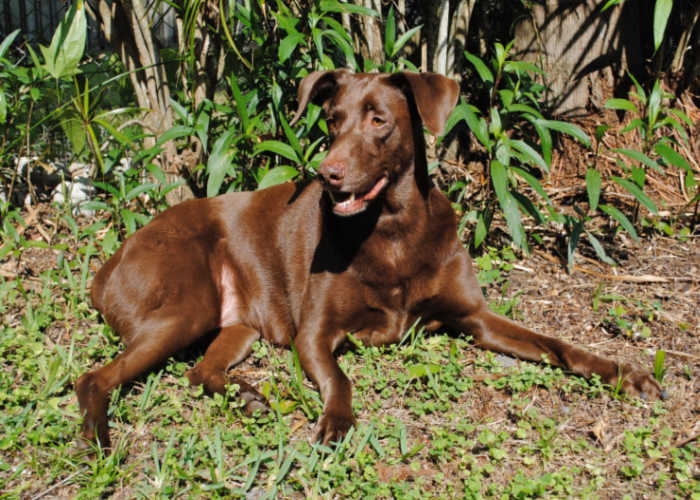
Table of Contents
It may be confusing, but it’s actually “Weimador.” It's a mix of two purebreds that have similarities in appearance but have two completely different purposes.
The Weimador is made to be the perfect companion and utility dog with a hint of elegance to their looks.
They’re also known as Labrador Weimaraner, Labraraner, Labmaraner, and Weibrador. This breed was designed for its mien, utility, and temperament.
The Weimador puppy is a mix of the Labrador and the Weimaraner breeds.
Although this breed is not recognized by the American Kennel Club, it is quite recognized in other organizations instead.

Weimador History
The Weimador’s history is still undetermined but there are some hints of their existence.
Their breed came from two pure-bred dogs: Labrador and Weimaraner. These two breeds have very different histories and purposes.
Labradors came from Newfoundland. They’re known as water dogs who live among fishermen helping with fishing activities.
The Weimaraner came from Germany and is known for its hunting capabilities.
Both pure breeds have a great companionship temperament but are different in utility. The Weimador is a designer breed dog, bred for its appearance along with its temperament and utility.
Physical Traits
The Weimador is tall, slim fit, but sinewy. The Weimador’s coat is short and straight but dense.
Their breed is made to look elegant with their greyish coat. The Weimador’s coat may be brown, black, grey, or silver, but always with a hint of grey.
The male Weimador stands at least 23 to 24 inches at 60 to 100 lbs, while the female Weimador stands at 21 to 22 inches at 58 to 98 lbs.
The Weimador’s head is quite big, making their facial feature appear smaller. The Weimaraner’s eyes are almond in shape, which may look similar to a human’s.
The Weimador’s eyes may come in two colors: blue or amber.
The Weimador’s muzzle is sleek and pointy but rounded near the tips. The Weimador has a noticeably large nose that is almost brown always.
The Weimador has a large set of ears that flops down toward its face. The ears are quite slender in width. The Weimador's mouth is quite long as well.
Their body is naturally slim and muscly, they may appear thin but their body is designed to look that way. Their body features are perfect for sporting activities.
With an arched chest toward their fore legs and hind legs, it is perfect for agility. Weimador paws are large while their tails are long.
Temperament of a Weimador
The Weimador was modeled from both its origin breed to have a friendly temperament, elegant looks, athletic capability, and utility skills.
Much like their origin breed, Weimadors are very much energetic and playful. Weimadors are very playful. With their amount of energy and their size, the outdoors is a must for them.
They do well with their owners and family members. They’re even great around children.
But this kind of dog should still be supervised around children. Their big stature comes with their big personality.
That playfulness may be fun but the over-excitement may not be contained around children.
It’s best to leave Weimador with their dam, sire, and litter for early socialization. As they grow up, they recognize certain forceful bites are painful to others as well.
They are best separated when they’re at least 12 weeks old.
Weimador is a companion dog and they have velcro dog tendencies. Weimadors need to be in the vicinity of their owner or families most of the time.
They’re very much attached and would like to be part of their activities as well.
Living with a Weimador
Weimador must not be left home alone for more than a couple of hours. They will need a companion if they’re to be left at home by a familiar person or in the boarding.
Weimadors who are left alone for long periods may develop anxiety, which later results in destructive habits.
The Weimador dog breed can do well with strangers. Owners must first display safety, security, and comfort around the stranger for Weimadors to feel the same.
They may not be aggressive, but their instinct to be alert is never absent.
Weimadors are good with other dogs and other animals as well, but to develop this temperament fully, early exposure is essential.
Weimadors have the instinct to hunt as to their Weimaraner-origin breed.
Early exposure and training will help avoid unwanted incidents. Since they are large breed dogs, it’s best to have control of the situation before it happens, as it may be difficult to manage.
Weimadors are flexible in terms of the living conditions of their owners, but providing an ample amount of space for them is important. This large breed requires daily exercise outside and playtime as well.
Weimadors are vocal as well. They may express their alertness and attention by barking, but other than that, they do not bark as much.
Weimadors may not be the best option for apartment pets, as they require ample space for walking around as well.
It’s best to have their outdoor daily exercise done. Homes with backyards will be great with them, too.
Weimadors will do well with cold and warm weather. Still, they may need to cover up during extremely cold weather and ventilation in hot weather.

Training & Exercise
Weimadors are quite excellent and clever. They will need a great amount of physical and mental stimulation.
They may be eager to please their owners, but they may be quite naughty at a young age. It’s important they see you as a firm leader to train them well.
Training Weimadors should be done while they’re young. Exposing them socially is great.
This will help them learn how to interact well with other people and animals as well. As they learn, they may develop their social interactions and behavior as well.
Weimadors are extremely bright, active, and energetic compared to their original breed. Weimadors will require daily exercises from walks to brisk runs, at least 40 minutes to an hour, split throughout the day.
You could do this so the Weimador may not feel bored and be satisfied as they have met their daily exercise requirement.
Weimadors’ exercise activities shouldn’t be limited to walking and running. The Weimador dog breed may accompany its owners in their exercise regimen, too.
Swimming, small hikes, jogs, frisbee, and other activities are also good exercises for them. It can also be considered play time and a bonding experience for them.
Spending time with Weimadors through activities like these will help build their relationship with their owner or family.
Weimador Health Care
Weimadors are healthy with the right diet, supplements, good living conditions, and exercise. These dogs can live up to 12 years.
Determining what disease Weimadors may have inherited may be difficult since their breed originally came from two breeds.
A way to find out is to study what the two breeds have as well. Here are some possible diseases Weimadors carry:
Bloat
Gastric torsion or bloat is a gastrointestinal condition wherein a dog’s stomach expands due to it teeming with fluid, food, or gas.
This can be a fatal circumstance if left untreated. In some cases, due to bloating, blood is trapped in the stomach, preventing return and proper flow.
Prevention includes preventing your dog from doing activities right after a meal, eating meals too fast, eating large meals throughout the day, and stressing them.
Treatment may depend on your veterinarian's observation.
Coper Associated Chronic Hepatitis
Copper-associated Hepatitis is the progressive accumulation of copper granules within the hepatocytes.
The abnormal amount of copper causes toxic oxidative damage and inflammation.
Ear Infection
Ear infection causes may vary but it’s essential to have them checked during regular visits to veterinarians.
If you notice shaking of the head, unpleasant odor in the ears, or overly scratching of their ears, do have them checked immediately.
Idiopathic Epilepsy
The causes of Idiopathic Seizures are unknown, but it is an inherited cognition. Some Weimador may suffer from this condition, and there is no known cure as of now.
Veterinarians may administer anti-seizure medication, but it can only decrease the severity of the seizure.
Make sure to have your Weimador checked immediately to provide the right medication for the condition.
Joint Problems (Hip Dysplasia and Osteochondritis Dissecans)
Hip dysplasia is a genetic condition wherein the socket of the joint and ball becomes distorted. When diagnosed with hip dysplasia, it’s important to keep their weight in the normal range and have them exercise with activities that promote joint therapy.
Veterinarians may prescribe medications and supplements for anti-inflammatory/ pain relievers.
Prevention is the same, keeping them active but not injuring them as well. A treadmill walk or swimming is perfect for prevention and recovery as well.
Osteochondritis Dissecans in dogs is the inflammatory condition of the joints when the cartilage separates from the bone.
Mostly, it is found in the shoulders, but it can also be found in areas where there are joints.
Symptoms may vary in seriousness, but the common symptoms are swelling of joints, obvious signs of pain when walking, lameness, and inability to walk due to pain.
This is a very painful disorder. Get the dog checked up with the veterinarian as soon as possible.
Treatment can include rest, medication, therapy, or surgery. Of course, it may depend on the results of their test.
Progressive Retinal Atrophy
Progressive Retinal Atrophy, or PRA, is a degenerative disease that affects the rod and cone cells in the eyes, leading to blindness.
It is an inherited disease, and it’s known to have no treatment. It can progress quickly from a year or two. Have your Weimador checked regularly to guarantee less risk to their health.
Von Willebrand’s Disease
Von Willebrand Disease is a bleeding disorder in dogs and humans that is caused by a lack of protein in the blood. The lack of protein disables clotting when open wounds and may result in blood loss.
Some symptoms may be sustained bleeding after surgery or trauma. Another is hemorrhage from various body parts, including the nose, oral mucous membrane, urinary bladder, and vagina.
Owners should check with their veterinarians for tests and further consultation regarding precautionary measures they have to take with Weimador, who has the disease.
If the disease has taken place and is not addressed immediately, it may become fatal for the dog.
Weimadors are not relatively new, but breeding two different breeds may accumulate diseases in their litter.
It’s best to adopt Weimadors from reputable breeders and have them tested as soon as possible as well.

Diet
Weimadors must have a high-quality diet. At least three or three and a half cups split into two meals a day is adequate. Owners may mix their diet with dry food, wet food, or homemade food.
Should they do so, it’s best to inquire with their veterinarians about what food they should focus on or avoid.
Fresh water is a must for these fur buddies. They are quite active, so they may want to hydrate frequently as well.
Grooming a Weimador
Weimador’s grooming is low maintenance. Since their coat is short and dense, grime and dirt do not hold onto it as much.
Weimador can be bathed at least twice or thrice a month and after messy activities. Drying their fur may take a bit of time, though it is short due to its dense nature.
Coat
Brushing their fur at least once to twice a week is adequate. This is to help their natural oils to be distributed properly from the skin to their fur.
Owners may use a pin or bristle brush when doing so. Their coat is naturally glossy, too.
So if owners notice their coat may lack this aspect in the fur, they may ask the veterinarian whether providing supplements for the skin and coat health is needed or not.
Ears
Another regimen we should carefully watch out for with Weimador is grooming their ears. Make sure to clean the Weimador’s ears after a bath or when it gets wet.
It’s important to dry it completely since moisture and build-up grime are big factors in infections.
This also applies after water activities. They may shake their heads on their own to clean their ears, but it’s best to assist them with drying their outer ear parts as build-up may begin the instant their ear folds fall.
Teeth
It's also best for Weimadors to have their teeth brushed once a week. Their diet may consist of wet and dry food that may get caught between their teeth.
Toys like rope or dental sticks may help lessen it, but brushing is still the best option for cleaning their teeth.
Nails Trimming
Weimador’s nails should be trimmed or filed at least once a week. Since they are large breed dogs, their nails grow a bit faster and are bigger as well.
Weimadors may find it difficult or painful if their nails are too long, so trimming or filing them weekly is a big help.
Weekly trimming isn’t necessary. Filing can be done if their nails are not that long. Instead, owners should just file the ends.
Weimadors are smart and very eager to please their owner. Owners can use this to train their Weimadors to recognize their grooming routine.
Some dogs, regardless of known temperament, may still find it uncomfortable with water or have their nails trimmed.
It’s best to introduce these activities when they're young. Owners may set aside treats or toys to present while doing the activity so the dog will not struggle.
As much as possible, holding their paws casually can help them think that it’s not a harmful activity.
Some Weimadors may have drooling tendencies, so maybe preparing towels is advisable.
Frequently Asked Questions About Weimadors
Why is my Weimador slobby?
In terms of grooming, Weimadors don’t take that much effort for them to be cleaned.
One of the most common comments about Weimador’s cleanliness is their drooling, especially when they’re hungry or eating.
Preparing a towel before their meal may be advisable. Their mouth should be wiped after a meal as needed to avoid slobby furs.
Are Weimador Dogs affectionate?
Yes, Weimadors are known to be quite affectionate, and even their origin breeds are known to be affectionate as well. Weimadors love to play, cuddle, and spend time with their owner or their family.
They thrive on human interaction and companionship, so it’s best to have someone with them all the time.
Are Weimadors smart?
Yes, Weimadors are quite smart. Their origin breeds are both utility dogs, which means they may require a great amount of mental and physical stimulation to satisfy their needs.
Being clever can be troubling, too, as they can get easily bored. It’s best to have their exercise or training in various activities to entice and persuade them.

Weimador Dog Breed Profile Summary
As we can see, Weimadors are great companion dogs. They can participate in service and athletic activities, but sadly, a lot of them end up in shelters due to a lack of awareness regarding their nature.
Weimadors are best in homes with wide space and a backyard. They’re best with owners or families who are always present around them.
Companion dogs thrive on their humans and have tendencies to have anxiety when they’re apart for a long period.
Weimadors puppies are still in their venture to be known to the world, and it’s our responsibility to bring healthy Weimadors today and in the future.
Breeding two different breeds means risking the litter with genetically inherited diseases. It’s best to have the dogs tested before proceeding to breed, which is a great way to start.
Open your mind to Weimadors if you want a dog that’s active, playful, affectionate, and great at service as well.












